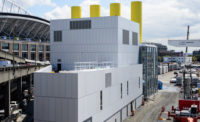TBM 'Bertha' Finally Rolling Along on Big Seattle Tunnel Job

Photo courtesy of STP

A Good ‘Low’ Point After two-plus years of delays, tunneling is proceeding under Seattle. Photo courtesy of STP


Bertha, the world’s largest-diameter tunnel-boring machine, sits at a low point in its 9,000-ft bore under downtown Seattle. But, this time, the much-maligned machine finds itself at a low point it wants.
Located about 120 ft beneath Spring Street, the 57.5-ft-dia machine has reached a planned maintenance stop 3,088 ft into the project that, ultimately, will give Seattle a bored tunnel to replace the aging Alaskan Way Viaduct. After a two-year-plus delay that required raising Bertha’s 4,000-ton face to the surface for repairs, getting to this point under Spring Street—the lowest grade the machine will reach in moving north to its exit portal, near the Space Needle—has elevated the mood of the project team, says Chris Dixon, Seattle Tunnel Partners project manager.
“We are very, very happy to be tunneling and making good progress,” Dixon says. “I know there was a lot of concern [regarding the repairs and finishing the job]. But I always had confidence” that we would succeed.
Bertha reached Safe Haven 3 for a planned maintenance stop in March and left on April 29. It averaged six tunnel rings per day in May and seven rings per day in June. On June 23, it paused for roughly six weeks to inspect and potentially replace cutterhead tools as part of hyperbaric maintenance carried out in conjunction with Ballard Marine Construction.
At the last stop, Seattle Tunnel Partners replaced 11 cutting tools after investigating and cleaning the eight cutterhead spokes. “It would be nice to find we do not have to replace any,” Dixon says. “The clay we have been going through isn’t an abrasive material, so we don’t anticipate excessive wear on the cutting tools.” The machine did have to bust through a relatively thick zone of concrete-type material when leaving the ground that was reinforced around Safe Haven 3.
Dixon expects Bertha to stop again for maintenance in about 2,000 ft and, after that, make a final stop another 2,000 ft. It will move up a 1.6% grade for 3,000 ft, a 3.6% grade for 2,000 ft and a 4% grade for the final 1,300 ft. During this portion of the job, the ground becomes more alluvial.
“We’re pleased with both the progress of the machine and Seattle Tunnel Partners’ ability to control the ground,” says Brian Nielsen, Washington State Dept. of Transportation deputy program administrator.






